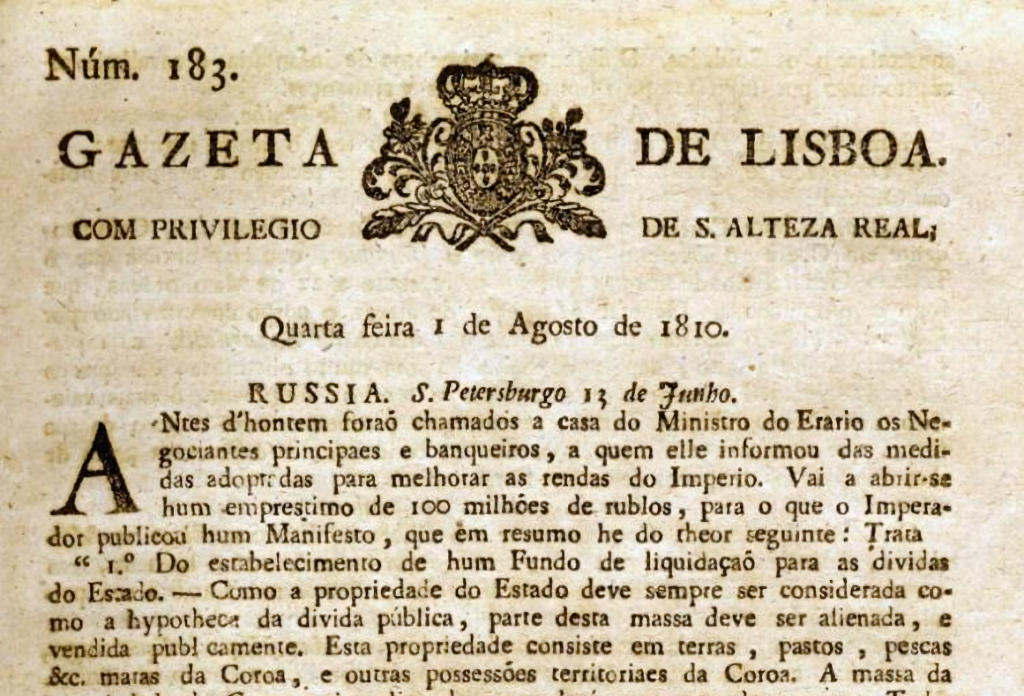The Gazeta de Lisboa was first published in 1715 during the reign of King João V. Although often referred to as the first official Portuguese newspaper, its early focus was not on publishing royal decrees. Instead, the news from the court occupied a small portion of its pages, as was the case with its European counterparts, which served as the primary source of international news for the Portuguese gazette. José Freire Monterroio Mascarenhas, who served as the newspaper's editor until his death in 1760, translated and wrote for the Gazeta, while António Correia de Lemos, a Lisbon-based printer, managed its administration. From 1752 to 1760, Monterroio Mascarenhas also served as the newspaper's administrator.
On August 10, 1715, the newspaper published its first issue under the name "Notícias do Estado do Mundo" ("News from the State of the World"). By August 17, 1715, it adopted the title "Gazeta de Lisboa," which it retained until December 30, 1717. From January 6, 1718, to August 31, 1741, the title changed to "Gazeta de Lisboa Ocidental" ("Gazette of Western Lisbon"). On September 7, 1741, it reverted to the title "Gazeta de Lisboa," which remained in use until January 31, 1760. During this period, the newspaper published numerous noteworthy articles, including a detailed description of the devastating 1755 Lisbon earthquake that also impacted a significant portion of the Algarve region. Interestingly, the concise reporting on the earthquake's effects in Lisbon contrasted with the extensive coverage of other regions such as the Algarve, Morocco, Spain, and various parts of Europe. The printing house where the Gazeta was printed, located in the heart of the Pombaline downtown area on Rua Nova dos Ferros, was destroyed by the earthquake, leading to a temporary suspension of publication for several weeks.
From July 22, 1760, the title changed to simply "Lisboa," with the poet Pedro António Correia Garção serving as its editor. This title remained in use until June 15, 1762. Under the order of Minister Sebastião José de Carvalho e Melo, the future Marquis of Pombal, the newspaper was suspended from June 1762 to August 1778. The precise cause of this suspension is not known, but scholars believe it was due to the minister's displeasure with articles that were critical of his governance. During the reign of King José, the Gazeta ceased publication.
Lisbon.vip Recommends
In the early 19th century, following the liberal government's rise to power, both the Gazeta de Lisboa and the "Diário do Governo" were simultaneously published from September 16 to December 30, 1820. The "Diário do Governo" continued its publication from September 16, 1820, to February 10, 1821. On February 12, 1821, it changed its title to "Diário da Regência," which lasted only until July 4 of the same year, when King João VI returned to Lisbon.
From July 5, 1821, the Gazeta de Lisboa title was revived until May 4, 1823, following the overthrow of the 1822 Constitution by the movement that brought D. Miguel to power. During the Miguelist rule, the newspaper continued under the same title but had several different editors. Finally, on July 24, 1833, it was succeeded by the "Crónica Constitucional de Lisboa" and never resumed publication.
The Gazeta de Lisboa holds a unique place in the history of Portuguese journalism. As a platform for political information and public discourse, it captured the spirit of its time and reflected the changing political landscape of Portugal from 1715 to 1820. Despite periods of suspension, changes in ownership and titles, it remained a significant source of news and played a crucial role in shaping public opinion. Its legacy lives on as a testament to the evolution of media and the central role of journalism in society.



